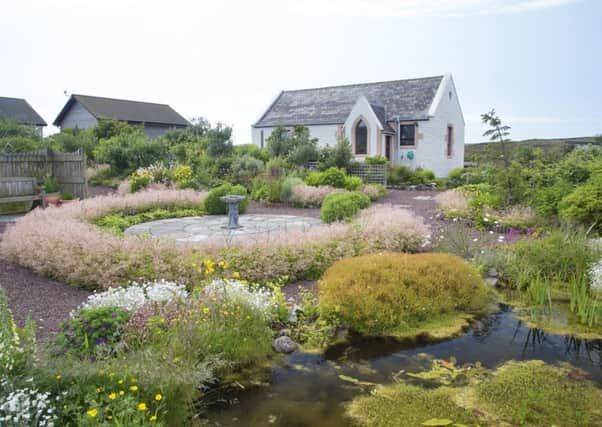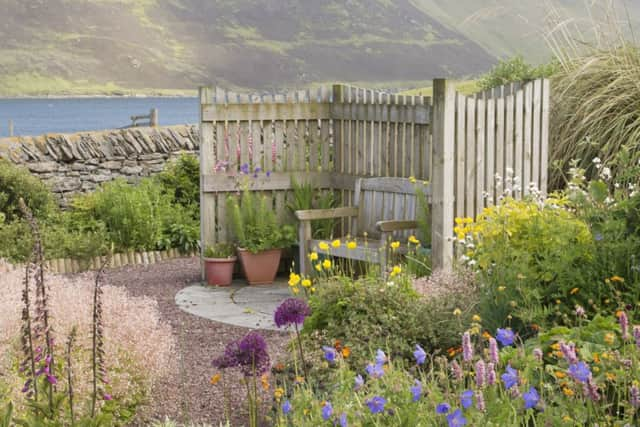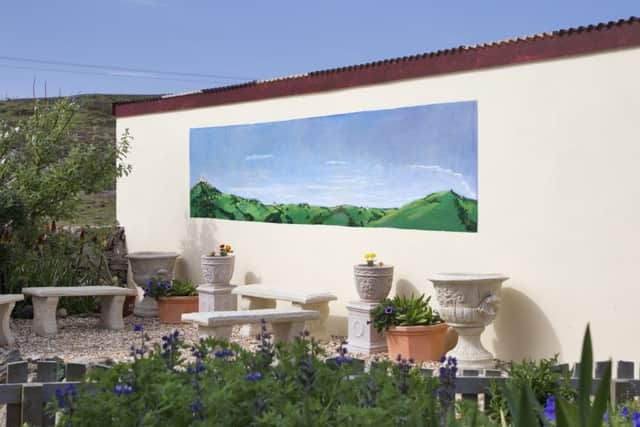Gardening: Growing in the Shetland wind


WHEN Maureen Christie called on James Thomason for help with her garden, a former school playground on the west coast of Shetland, the artist and garden designer commented this was the windiest site he had ever encountered. When a Shetlander by birth with a deep knowledge of local conditions makes such a comment, it is time to take note.
And yet, as Maureen points out, exposed, open sites often boast the best views. At Trondra the views are stunning. Perched on the side of the hill, the converted single-room school enjoys east-facing views over the Clift Voe with the Clift Hills rising out of the sea. Sheep graze in the fields below the house.
Advertisement
Hide AdAdvertisement
Hide AdMaureen explains: “I came up here on holiday from England in 1982 and saw an interesting post advertised in the local paper.”


Deciding to stay she later purchased the former school, which closed when the bridge between Scalloway and Trondra opened in 1971. “I started working on the garden nine years ago, after I had indulged in travelling widely when I first retired.”
Seeing the flower-filled space it is hard to believe that Shetland ponies and sheep grazed all but a strip in front of the house. Fortunately their tiny feet aerated the grass, while their droppings enriched it.
With James’s help, an ongoing plan was established. The 1.3 acre plot was partially enclosed by the 19th century drystane dykes punctuated vertically by gateposts. Gradually a graceful, flowing layout of island beds was established. For ease of maintenance the stone-framed beds, none of which are more than 7ft wide, were separated by stone slabs set in gravel.
More shelter against the 80 mile-an-hour winds was needed when a remnant of the original playground wall dating from 1875 proved too low to protect plants and varieties of fast-growing Icelandic and Alaskan willows were introduced, including Salix pylicifolia and S. alaxensis.


With their attractive silvery foliage these robust willows have replaced sycamore as the most attractive shelter plants for Shetland. A perimeter hedge was also planted along the west boundary, which was supplemented in places with the white flowering Daisy Bush Olearia macrodonta.
When it came to filling the island beds, colour, texture and variety were key, and experimenting part of the fun. Maureen explains: “I have been quite adventurous; I have tried lots of things. I see things I like and I try them. Some things have worked, but plenty of others haven’t.”
Success has come from low-growing plants like pink flowering Saxifrage, which creates a stunning circular edging. In late spring, purple lupins, deep pink astilbe, blue and white geraniums, and pink and white foxgloves combine with purple-headed alliums. Later, white Shasta daisies, purple asters, and pink and cream Stargazer lilies take centre stage.
Advertisement
Hide AdAdvertisement
Hide AdTowards the end of the short but intense season – with 23 hours of daylight – the scheme warms up with sprays of scarlet Crocosmia Lucifer combined with the orange flowers of its humbler cousin, often flowering well into October. Drifts of red sedum and deep orange Kniphofia add their warm tones to the mix. To her surprise, Maureen found last year that Gladioli planted among the shrubs survived the rain and wind, and kept recovering. Reliable background performers include scented, semi-evergreen yellow flowering Southernwood, Artemisia abrotanum. Height and movement come from tall, silvery plumes of Pampas grass.
Seeds, such as white Cosmos, blue Nigella and Eryngium are started in the garage where the Perspex roof allows enough light for germination. Maureen makes plenty of compost to nourish and protect young and established plants, and give them the best start to the year.
Living in such a rural location you might question the need to provide for wildlife, but Maureen explains that a bird bath and feeders close to the house are regularly visited by starlings and sparrows, with the occasional small rock dove and collared dove groups calling.
The gardening partnership with James proved stimulating and creative. Maureen says, “James is an instinctive gardener, he has a flair for combining shape, colour and texture of shrubs and flowers with the flowing movement of grasses.”
There is a new project every year, to keep things fresh. Last year saw the introduction of the Italian garden corner, complete with a mural, painted by James, at the side of the house. Here agapanthus and daisies are the star performers.
This year’s project, introduced with the touch of humour that underpins everything done in the garden, is, Maureen explains, “A triple-layered circular archaeological site with pre-historic pretension. Gardens can’t stand still. There is so much to learn from visitors to the garden, who are encouraged to comment, give advice and make suggestions.”
The former playground of the Old School, Old School Road, Trondra, Shetland ZE1 0XL is open to anyone passing or by appointment: Maureen Christie (01595 880 372, [email protected])
Many of Maureen’s plants come from Planticrub, owned by keen plantsman Olaf Isbister. (www.plantiecrub.co.uk) James Thomason, Nonavaar, Levenwick, Sheltand (01950 422 447)
Antoinette Galbraith and Ray Cox travelled to Shetland with Logan Air (www.loganair.co.uk)